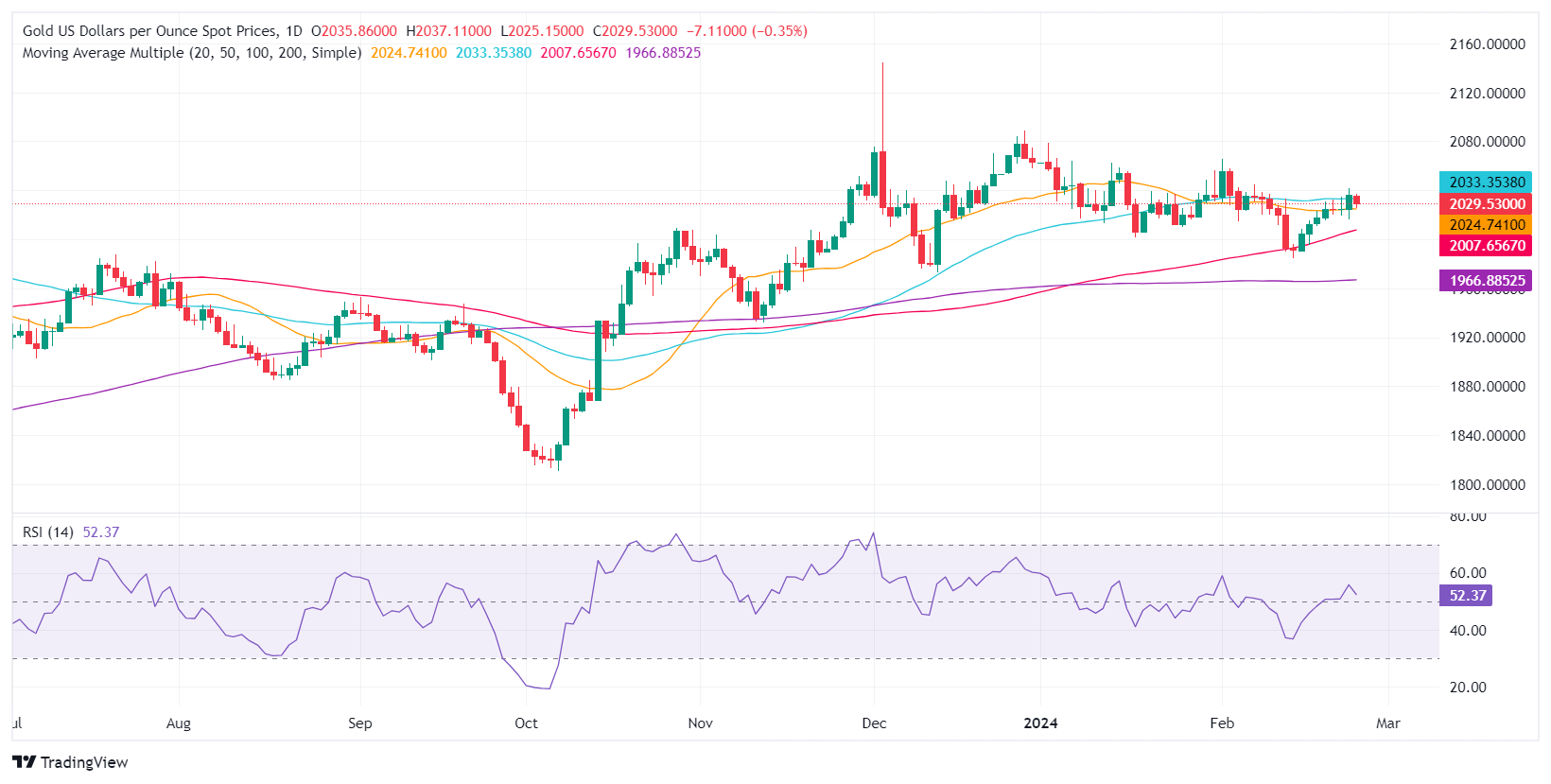- Gold falls to $2,026.93, pressured by the strengthening of the Dollar and the increase in Treasury yields.
- Markets reevaluate the Fed's rate cut schedule, with a 50% chance of possible easing in June.
- US 10-year Treasury yield around all-time highs capping Gold price.
The price of Gold retreats after reaching the 50-day SMA at $2,033.67 during the European session and loses 0.40% while the Dollar falls. However, rising US 10-year Treasury yields and decreasing chances of dovishness from the US Federal Reserve (Fed) have led to a decline in the unprofitable metal. XAU/USD is trading at $2,026.93, after reaching a high of $2,037.07.
Sentiment remains mixed, although slightly negative, in favor of the US dollar. Interest rate speculators have ruled out a Fed rate cut in March and May. By June, the odds of a quarter-percentage-point rate cut stand at 50%. The yield on 10-year US Treasury bonds rises four and a half points to 4.295%, far from reaching the maximum so far this year (4.354%), although it maintains pressure on the yellow metal, as investors They align with Fed officials' stance of three rate cuts by the end of 2024.
Daily Market Summary: Gold's Advance Capped by Rising US Yields
- Regarding the data, new home sales in the US rose 1.5%, from 0.651 million to 0.661 million, less than the 0.68 million expected.
- The Dallas Fed Manufacturing Index for February contracted -11.3 although it improved compared to January's -27.4 contraction, suggesting that business activity is recovering.
- The January Minutes of the Federal Open Market Committee (FOMC) reveal that policymakers are cautious about reducing interest rates, mainly due to the recent pick-up in inflation measures. Even recognizing that the risks associated with fulfilling its dual mandate of price stability and maximum employment are increasingly balanced, the Fed intends to remain “very attentive” to inflation. This attention comes even as they recognize that economic risks lean toward a recession.
- Elsewhere, the U.S. labor market remains strong, after the latest initial jobless claims data reflected fewer Americans filing for unemployment benefits.
- U.S. business activity moderated in February, S&P Global showed. The services and composite indexes expanded below the previous month's reading, although manufacturing surprisingly jumped out of contraction territory.
- Investors expect an easing of 85 basis points throughout 2024.
- The Dollar Index, which tracks the performance of the Dollar against a basket of six major currencies, is currently trading near 103.84, losing 0.12%.
- New York Fed President John Williams said the Fed is on track to cut interest rates “later this year.” He noted that inflation's progress toward the central bank's 2% target would be “bumpy,” but overall the economy is headed “in the right direction.”

On Monday, Friday's note is repeated: “Gold has changed to a neutral upward bias while holding on to the 50-day SMA.”
Even though challenge of the daily high of October 27 turned into support at $2,009.42. Once broken, that will expose key technical support levels, such as the 100-day SMA at $2,007.82, followed by the 200-day SMA at $1,966.79.
On the other side, buyers dragging the XAU/USD spot price above the 50-day SMA could pave the way to challenge $2,050. Once these levels are broken, the next target would be the February 1 high of $2,065.60, before the December 28 high of $2,088.48.
Frequently asked questions about central banks
What does a central bank do?
Central banks have a key mandate to ensure price stability in a country or region. Economies constantly face inflation or deflation when the prices of certain goods and services fluctuate. A constant rise in the prices of the same goods means inflation, a constant fall in the prices of the same goods means deflation. It is the central bank's job to keep demand in line by adjusting its interest rate. For the largest central banks, such as the US Federal Reserve (Fed), the European Central Bank (ECB) or the Bank of England (BoE), the mandate is to keep inflation close to 2%.
What does a central bank do when inflation is below or above the expected target?
A central bank has an important tool to raise or lower inflation: modify its reference interest rate. At pre-communicated times, the central bank will issue a statement with its reference interest rate and give additional reasons why it maintains or modifies it (cuts or raises it). Local banks will adjust their savings and loan rates accordingly, which in turn will make it harder or easier for citizens to make a profit on their savings or for companies to borrow and invest in their businesses. When the central bank substantially raises interest rates, we speak of monetary tightening. When you reduce your reference rate, it is called monetary easing.
Who decides monetary policy and interest rates?
A central bank is usually politically independent. Members of the central bank's policy council go through a series of panels and hearings before being appointed to a position on the policy council. Each member of that council usually has a certain conviction about how the central bank should control inflation and the subsequent monetary policy. Members who want a very loose monetary policy, with low rates and cheap loans, to substantially boost the economy, while settling for inflation slightly above 2%, are called “doves.” Members who prefer higher rates to reward savings and want to control inflation at all times are called “hawks” and will not rest until inflation is at 2% or just below.
Is there a president or head of a central bank?
Typically, there is a chairperson who leads each meeting, has to create a consensus among the hawks or doves, and has the final say when votes need to be divided to avoid a 50-50 tie on whether to adjust current policy. The president will give speeches, which can often be followed live, in which he will communicate the current monetary stance and outlook. A central bank will try to push its monetary policy forward without causing wild swings in rates, stocks, or its currency. All central bank members will channel their stance toward markets ahead of a monetary policy meeting. A few days before a monetary policy meeting is held and until the new policy has been communicated, members are prohibited from speaking publicly. This is what is called the silent period.
Source: Fx Street
I am Joshua Winder, a senior-level journalist and editor at World Stock Market. I specialize in covering news related to the stock market and economic trends. With more than 8 years of experience in this field, I have become an expert in financial reporting.







